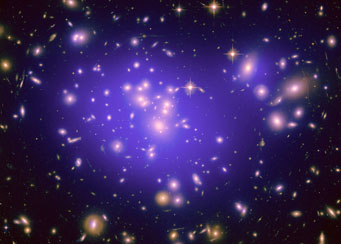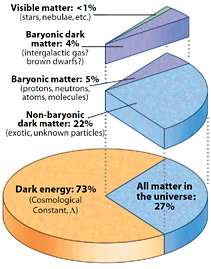The notion that a massive object can literally bend light, what we now call gravitational lensing, has been around for more than 200 years — though Einstein gets the nod for making the effect widely known and getting it right.

Distorted galaxies rim the edges of the gravitational lens Abell 1689, a galaxy cluster 2.2 billion light-years distant in Virgo. The purple overlay on this Hubble Space Telescope image shows the distribution of dark matter within the cluster. Click here for a larger view.
NASA / ESA / E. Jullo / P. Natarajan / J-P. Kneib
Ever since the 1979 discovery of a distant quasar "lensed" into two images by an intervening galaxy, observers have amassed all sorts of gravitationally mangled novelties — none more famous than QSO 2237+0305, the Einstein Cross. By carefully dissecting these cosmic mirages, cosmologists can learn much about the lensing objects in the foreground, such as how much unseen dark matter is fortifying their mass, and about the distances to the farther objects being distorted.
Now a group headed by Eric Jullo (Jet Propulsion Laboratory) and Priyamvada Natarajan (Yale) has used the light-bending power of the massive galaxy cluster Abell 1689 to refine our conceptions about the mysterious, antigravity-like phenomenon called dark energy.
In August 20th's Science, these researchers describe how they used images of Abell 1689 from the Hubble telescope's Advanced Camera for Surveys to identify 114 visible manifestations of 34 different background galaxies. Then Keck and Very Large Telescope spectrographs pinned down distances to 24 of those galaxies.
The team used these observations not only to reconstruct the paths taken by light from each background galaxy, but also to model how dark energy altered the geometry of space along the route. “The precise effects of lensing depend on the mass of the lens, the structure of spacetime, and the relative distance between us, the lens and the distant object behind it,” Natarajan explains in a press release about the results.

Here's the recipe for our universe, as presently understood. Baryonic matter, the building blocks of atoms and molecules, accounts for just under 5% of all matter and energy. Instead, our universe appears to be dominated by unseen and mysterious dark matter and dark energy.
Sky & Telescope illustration
The goal was to tighten the constraints on the dark-energy density in the universe. There's much more to the universe than the normal "stuff" (consisting of protons, neutrons, and electrons) that we can see or sense. Cosmologists currently favor a universe in which this baryonic matter is merely 4.5% of all matter, with as-yet-unidentified dark matter adding another 22%.
The remaining 73%, they believe, is accounted for by the "dark energy" that's making the expansion of the universe speed up — and the leading candidate for that is something dreamed up by Einstein in the 1920s as a fudge factor for general relativity, now termed the cosmological constant and abbreviated Λ (Lambda).
(Trust me: no one-liner at a star party will prove your astro-smarts faster than uttering, "Why, yes — I do support a Lambda-cold-dark-matter cosmology.")
Jullo, Natarajan, and their colleagues find that cosmologists' assumptions about the ΛCDM's "equation of state" are reasonably well matched by their observations of Abell 1689. In that sense, nothing's new. Prior results using Type Ia supernovae and other approaches likewise support a ΛCDM cosmology (that is, that the dark energy's equation of state, known as w, is exactly equal to –1). But the Abell 1689 work represents a new and arguably more robust way to get there. "We have to tackle the dark energy problem from all sides,” Jullo notes in a second press release. "It’s important to have several methods, and now we’ve got a new, very powerful one.” They say they've narrowed the value of w to –1 to an uncertainty now of just 7%, including others' work with theirs.
As they conclude in their full paper (warning: not for the fainthearted!), it's a technique that will get even better once observations of ultra-distant objects start rolling in from the forthcoming James Webb Space Telescope.
 3
3
Comments
John Umana
August 23, 2010 at 6:52 pm
73% of the pie of all things (all matter and energy) is in fact "dark energy" -- the repulsive force behind the continuing expansion of the universe, which is accelerating. Einstein's cosmological constant (which he thought was a blunder) is indeed real. The real question is, what is the origin of dark energy? What exactly is this force? Dark energy is a force or forces that are external to the physical universe but which act upon it, such that the total pie of all matter and energy is steadily increasing. In other words, the mass of the universe is increasing, and the universe "weighs" more each instant of time.
You must be logged in to post a comment.
Peter Wilson
August 24, 2010 at 8:25 am
The fact that the universe appears flat, lambda has a non-zero value, and now w equals exactly -1, suggests astrophysicists are missing some underlying relationship. As it stands, DE is Hoyleâs steady-state with a twist. Energy appears out of nowhere, instead of hydrogen atoms. Not a satisfying explanation.
You must be logged in to post a comment.
Brian Surette
August 24, 2010 at 11:08 am
You are not taking "de Sitter space" into consideration. Matter and mass is not increasing. Spacetime is stretching. Think about the poppy seed muffin analogy. At first the poppy seeds and dough are compacted. When it cooks, the dough stretches and the poppy seeds separate. As volume increases in the muffin we do not gain more poppy seeds. The muffin just stretches like the spacetime fabric. Volume increases not mass.
You must be logged in to post a comment.
You must be logged in to post a comment.